Influence of Temperature Field Distribution on the Growth of Aluminum Nitride Crystal by Simulation Technology
Abstract
:1. Introduction
2. Experimental
3. Results and Discussion
3.1. Effect of Heating Body Position on Temperature Distribution
3.2. Effect of Heating Body Position on Crystal Growth Rate
3.3. Characterization of AlN Single Crystal
4. Conclusions
Author Contributions
Funding
Institutional Review Board Statement
Informed Consent Statement
Acknowledgments
Conflicts of Interest
References
- Grandusky, J.R.; Gibb, S.R.; Mendrick, M.C.; Moe, C.; Wraback, M.; Schowalter, L.J. High Output Power from 260 nm Pseudomorphic Ultraviolet Light-Emitting Diodes with Improved Thermal Performance. Appl. Phys. Express 2011, 4, 082101. [Google Scholar] [CrossRef]
- Hirayama, H.; Yatabe, T.; Noguchi, N.; Ohashi, T.; Kamata, N. 231–261 nm AlGaN Deep-Ultraviolet Light-Emitting Diodes Fabricated on AlN Multilayer Buffers Grown by Ammonia Pulse-Flow Method on Sapphire. Appl. Phys. Lett. 2007, 91, 071901. [Google Scholar] [CrossRef]
- Kneissl, M.; Yang, Z.; Teepe, M.; Knollenberg, C.; Schmidt, O.; Kiesel, P.; Johnson, N.M. Ultraviolet Semiconductor Laser Diodes on Bulk AlN. J. Appl. Phys. 2007, 101, 123103. [Google Scholar] [CrossRef]
- Wunderer, T.; Chua, C.; Northrup, J.; Yang, Z.; Johnson, N.M.; Kneissl, M.; Garrett, G.A.; Shen, H.; Wraback, M.; Moody, B.; et al. Optically Pumped UV Lasers Grown on Bulk Al N Substrates. Phys. Status Solidi 2012, 9, 822–825. [Google Scholar] [CrossRef]
- Radhakrishnan, S.R. Native Seeding and Silicon Doping in Bulk Growth of AlN Single Crystals by PVT Method. Phys. Status Solidi 2014, 11, 545–548. [Google Scholar] [CrossRef]
- Satoh, I.; Arakawa, S.; Tanizaki, K.; Miyanaga, M.; Yamamoto, Y. Sublimation Growth of Nonpolar AlN Single Crystals and Defect Characterization. Phys. Status Solidi 2010, 7, 1767–1769. [Google Scholar] [CrossRef]
- Zuo, S.; Wang, J.; Chen, X.; Jin, S.; Jiang, L.; Bao, H.; Sun, W.; Wang, W. Growth of AlN Single Crystals on 6H-SiC(0001) Substrates with Al N MOCVD Buffer Layer. Cryst. Res. Technol. 2012, 47, 139–144. [Google Scholar] [CrossRef]
- Baker, T.; Mayo, A.; Veisi, Z.; Lu, P.; Schmitt, J. Hydride Vapor Phase Epitaxy of AlN Using a High Temperature Hot-wall Reactor. J. Cryst. Growth 2014, 403, 29–31. [Google Scholar] [CrossRef]
- Hartmann, C.; Dittmar, A.; Wollweber, J.; Bickermann, M. Bulk AlN growth by physical vapour transport. Semicond. Sci. Technol. 2014, 29, 084002. [Google Scholar] [CrossRef]
- Wu, H.-L.; Zheng, R.-S.; Yan, Z.; Li, M.-M.; Zheng, W. Effect of temperature distribution on growth habit of AlN crystal. J. Shenzhen Univ. Sci. Eng. 2012, 6, 471–580. [Google Scholar] [CrossRef]
- Wang, G.; Zhang, L.; Wang, Y.; Shao, Y.; Chen, C.; Liu, G.; Wu, Y.; Hao, X. Effect of temperature gradient on AlN crystal growth by PVT method. Cryst. Growth Des. 2019, 19, 6736–6742. [Google Scholar] [CrossRef]
- Kuball, M.; Hayes, J.M.; Shi, Y.; Edgar, J.H.; Prins, A.D.; van Uden, N.W.A.; Dunstan, D.J. Raman scattering studies on single-crystalline bulk AlN: Temperature and pressure dependence of the AlN phonon modes. Crys. J. Growth 2001, 231, 391–396. [Google Scholar] [CrossRef]
- Davydov, V.Y.; Kitaev, Y.E.; Goncharuk, I.N.; Smirnov, A.N.; Graul, J.; Semchinova, O.; Uffmann, D.; Smirnov, M.B.; Mirgorodsky, A.P.; Evarestov, R.A. Phonon dispersion and Raman scattering in hexagonal GaN and AlN. Phys. Rev. B 1998, 58, 12899. [Google Scholar] [CrossRef]
- Kuball, J.M.M.; Hayes, A.D.; Prins, N.W.A.; vanUden, D.J.; Dunstan, Y.; Shi, J.H. Raman scattering studies on single-crystalline bulk AlN under high pressures. Appl. Phys. Lett. 2001, 78, 724. [Google Scholar] [CrossRef]
- Wang, Q.; Lei, D.; He, G.; Gong, J.; Huang, J.; Wu, J. Characterization of 60 mm AlN Single Crystal Wafers Grown by the Physical Vapor Transport Method. Phys. Status Solidi 2019, 216, 1900118. [Google Scholar] [CrossRef]

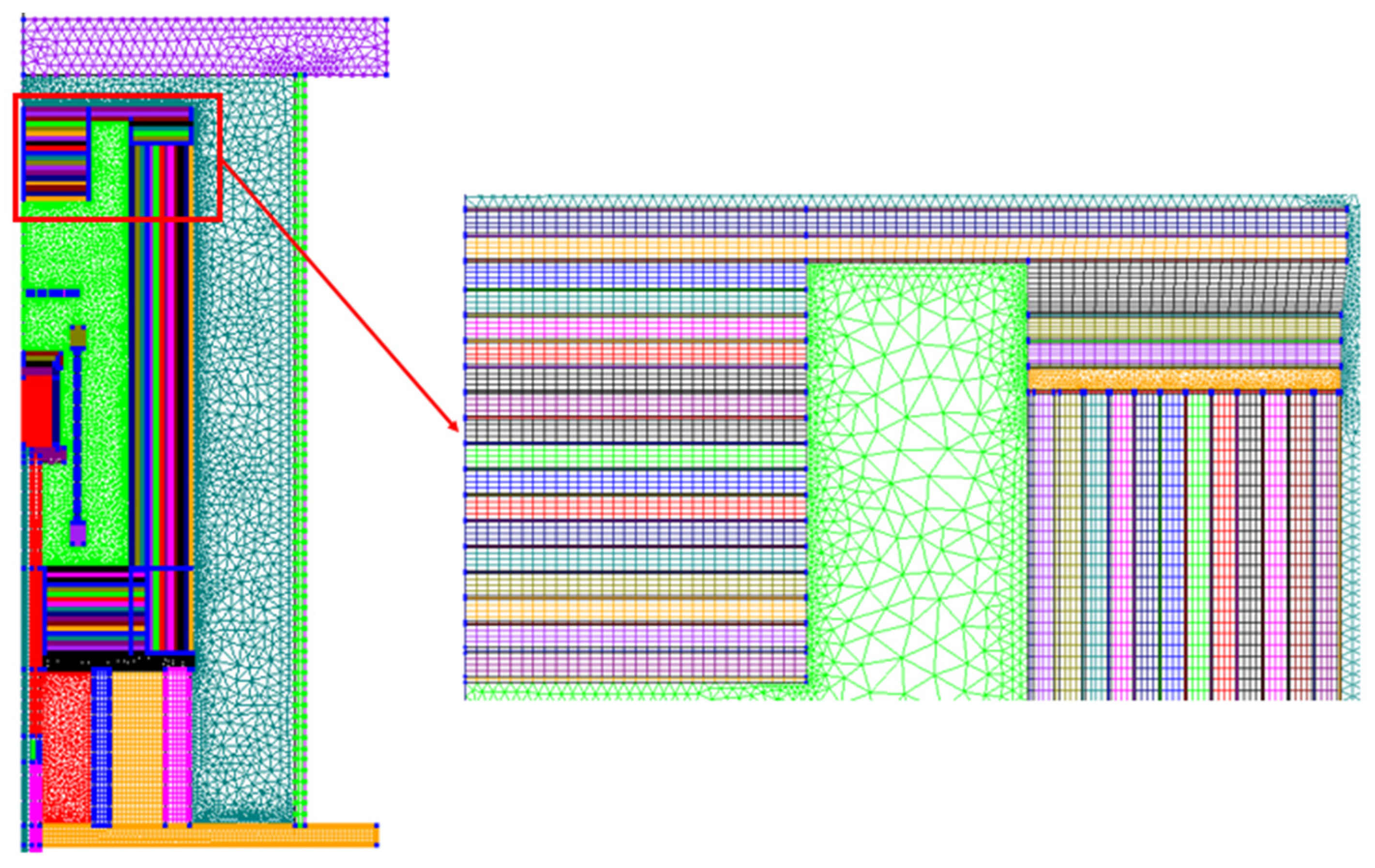
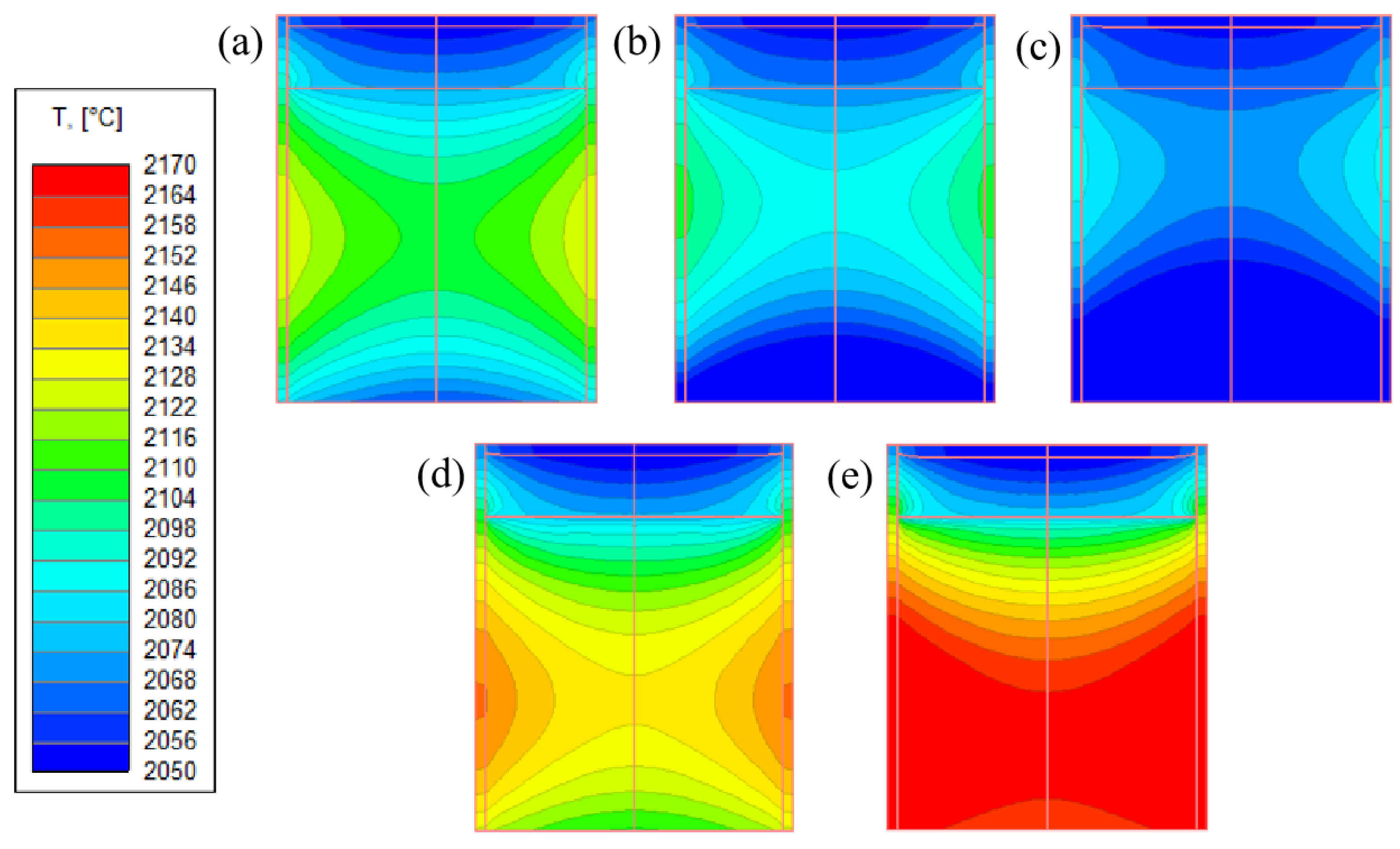

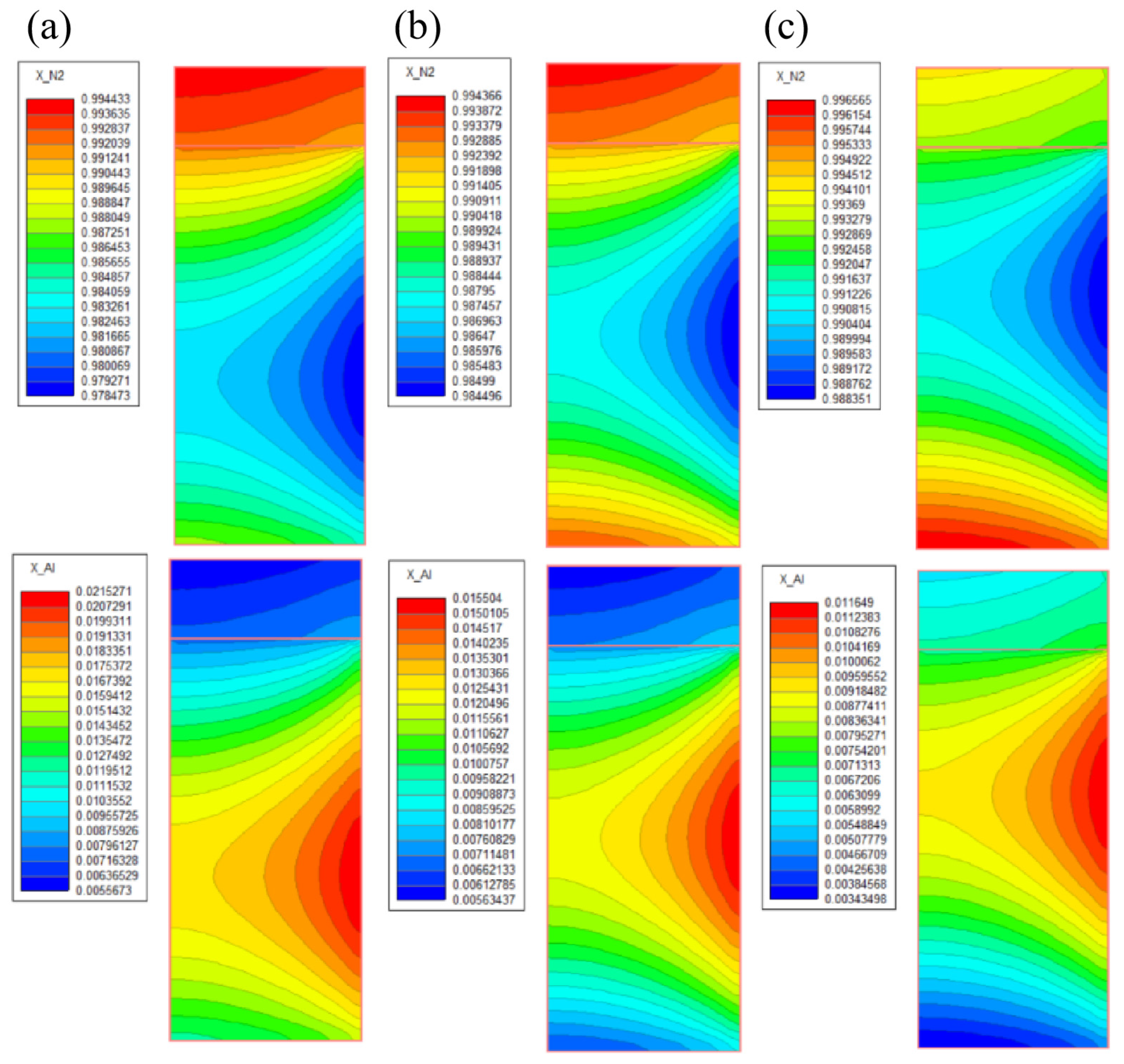
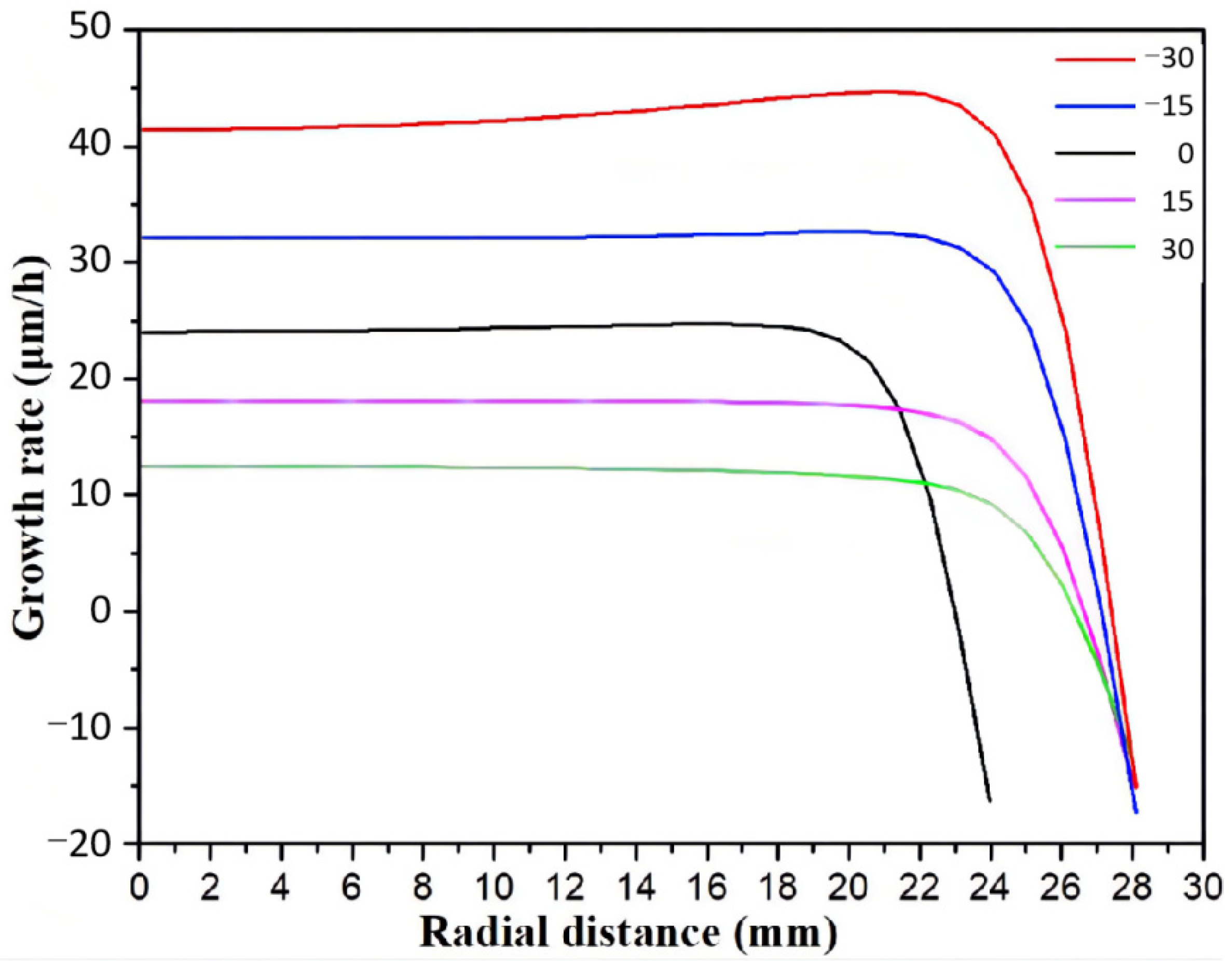


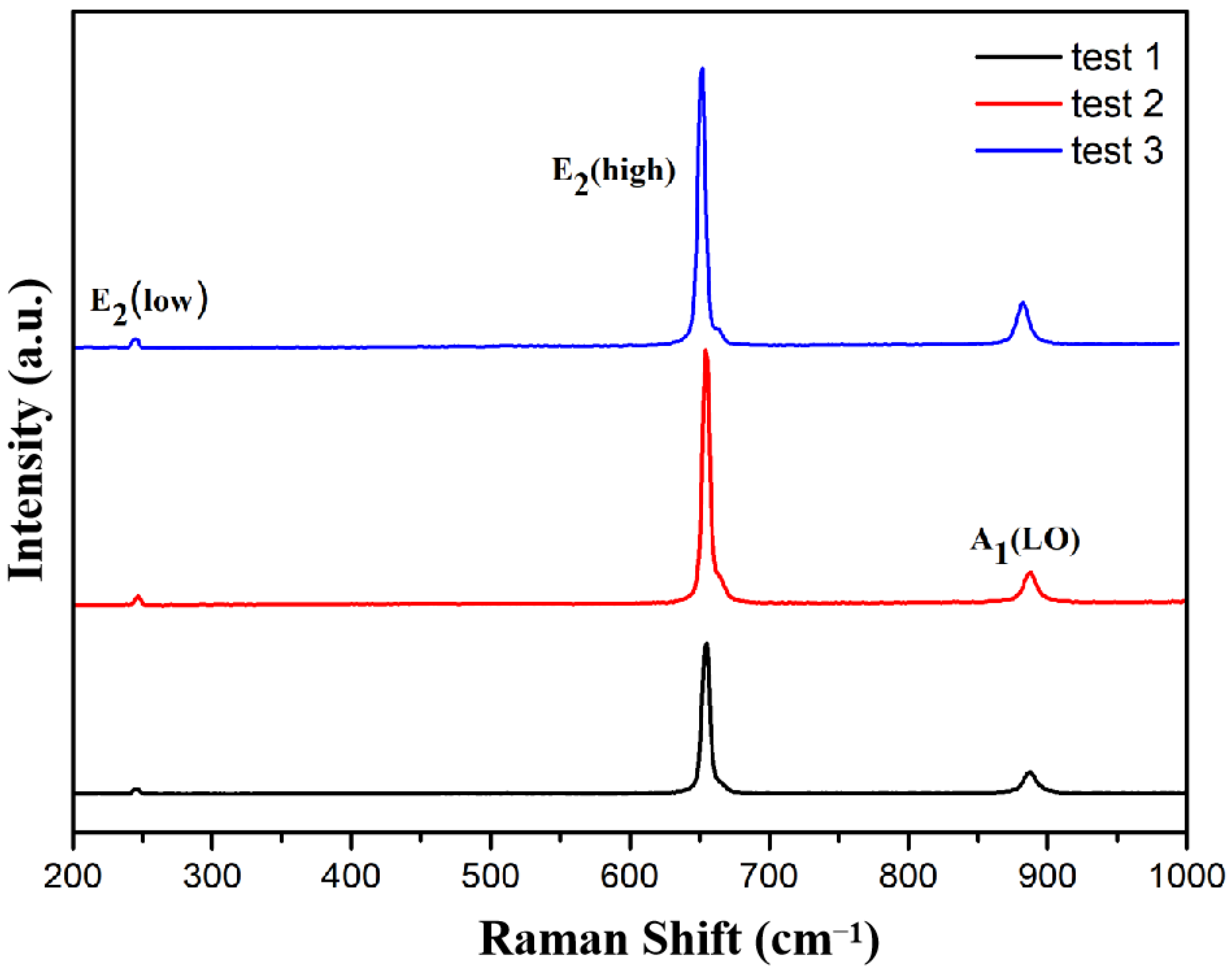
| Categories | Parameters |
|---|---|
| Furnace height (mm) | 850 |
| Furnace inner diameter (mm) | 480 |
| Thickness of furnace wall (mm) | 10 |
| Thickness of thin layer (mm) | 0.4 |
| Height of heater (mm) | 220 |
| Categories | Parameters |
|---|---|
| Diameter (mm) | 850 |
| Thickness (mm) | 480 |
| Diameter and thickness of Ta plate (mm) | φ60 × 2 |
| Al surface | As grown |
| FWHM (arcsec) | 400 |
| Purity | Si~5%, C~5% |
| Categories | W | Mo | AlN Crystal | Raw Materials |
|---|---|---|---|---|
| Thermal conductivity (W/(m K)) | Polynomial (120.66, 1066 K) | Table (112, 1000 K) | Power-Exponential (107.1, 454 K) | - |
| Conductivity ((Ω m)−1) | 1.9 × 107 | 1.99 × 107 | 1 × 10−10 | 1 |
| Density (kg/m3) | 19,350 | 10,220 | 3255 | 3255 |
| Heat capacity (J/(kg K)) | Polynomial (160.39, 1619 K) | Table (294, 1000 K) | Table (1167, 1000 K) | 1000 |
| Young’s modulus (GPa) | 411 | 329 | - | - |
| Poisson’s ratio | 0.28 | 0.31 | - | - |
| Surface emissivity | 0.287 | 0.254 | 0.9 | 0.8 |
| Categories | Residual | Relaxation | Iterations |
|---|---|---|---|
| Temperature | 1 × 10−6 | 0.97 | 5000 |
| Species | 1 × 10−5 | 0.95 | 5000 |
| Velocity | 1 × 10−4 | 0.95 | 5000 |
| Pressure | 1 × 10−4 | 0.95 | 5000 |
| Static Pressure | 1 × 10−5 | 0.7 | 5000 |
| Total Pressure | 1 × 10−6 | 0.7 | 5000 |
| Growth Rate | 1 × 10−4 | 1 | - |
| Thermal stress | 1 × 10−5 | - | 10,000 |
Publisher’s Note: MDPI stays neutral with regard to jurisdictional claims in published maps and institutional affiliations. |
© 2022 by the authors. Licensee MDPI, Basel, Switzerland. This article is an open access article distributed under the terms and conditions of the Creative Commons Attribution (CC BY) license (https://creativecommons.org/licenses/by/4.0/).
Share and Cite
Zhang, S.; Yuan, W.; Fan, G.; Li, T.; Zhao, L. Influence of Temperature Field Distribution on the Growth of Aluminum Nitride Crystal by Simulation Technology. Crystals 2022, 12, 1320. https://doi.org/10.3390/cryst12091320
Zhang S, Yuan W, Fan G, Li T, Zhao L. Influence of Temperature Field Distribution on the Growth of Aluminum Nitride Crystal by Simulation Technology. Crystals. 2022; 12(9):1320. https://doi.org/10.3390/cryst12091320
Chicago/Turabian StyleZhang, Shengtao, Wenbo Yuan, Guofeng Fan, Tie Li, and Lili Zhao. 2022. "Influence of Temperature Field Distribution on the Growth of Aluminum Nitride Crystal by Simulation Technology" Crystals 12, no. 9: 1320. https://doi.org/10.3390/cryst12091320




